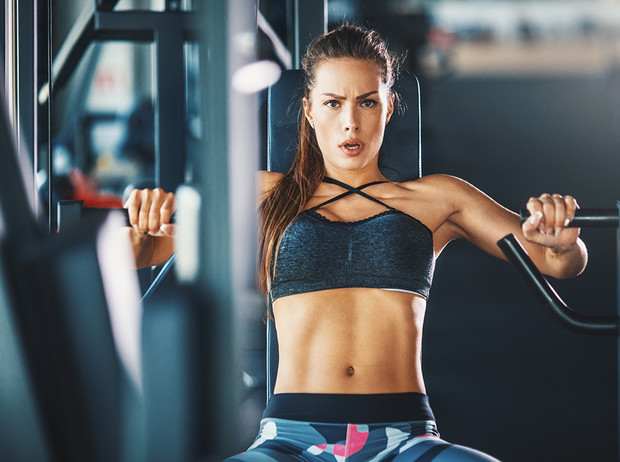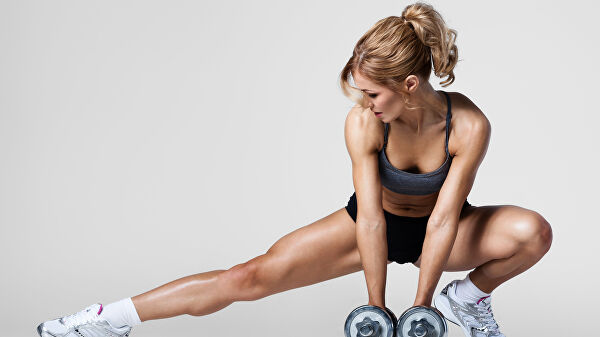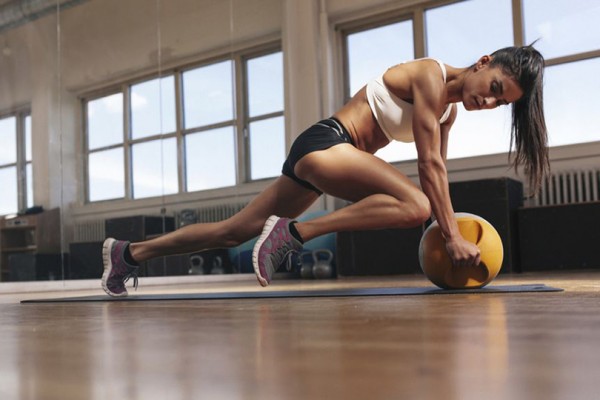1 – We will first discuss the basics:
- The head, upper back, buttocks and legs are in contact with the bench or floor.
- The shoulder blades are retracted to keep your chest up. The back is slightly arched.
- You lower the axis onto the nipples and your elbows are vertically below the axis.
- You push the axis to the level of the arms. Keep going so you don’t lose your retracted blades.
Now something about footwork. Although we push the axis emotionally from the chest, it is actually attracted by the floor. We’re just trying to keep her from falling on her. For maximum strength, we must also push ourselves into the floor.
The biggest mistake I see is the position of the feet. The classic 90 ° angle at the knees and feet flat on the ground works with a lighter weight, but with a little fatigue and a heavier weight it will be a problem.
Too big an angle at the knee joint will force you to lift your butt. And this is not only inefficient, but literally shameful.
Lifting your buttocks will be a little harder if you have a slightly less than 90 ° angle at your knees and have a slightly raised heel. Most of the work will be done by the abdomen of the feet and toes.
Since the strength of the legs will act not only upwards, but also a little forward, you will engage the quadriceps and the chain of the back of the body. This will improve the quality of the whole exercise. Try it.

2 – Push from the stops as often as you bench
There is not enough love for this exercise. Not only does it protect your shoulders with a shortened range of motion – it removes even the most delicate portion – but it also forces you to push from a complete stop.
This is essential for strength development because momentum does not help you. In addition, this exercise will help you to bench longevity with its gentleness.
3 – Isometry to force
Isometric work creates a positional force at different bending angles in the joint and can also increase mobility. Here, however, we will use it to start the nervous system before heavy training.
You can also use this method as a stand-alone training by simply adding more time and workload to isometric series. The goal is to exhaust motor units with a high connection threshold and repeat the series for about 15 seconds.
The key is to work as hard as possible. If you relax a little, it will not be effective. And remember that with isometry, the risk of injury is very low. Without movement, it is harder for something to go wrong. So adjust the joints to the desired angle and go for it.
Practice 1-2 series before a heavy benche workout. He will then be of better quality.
4 – Don’t forget compound series
A composite series is not a super series. Superseries pair exercises for unrelated muscle groups. Like bench and biceps.
The composite series pairs the exercises to the same or synergistic group of muscles. For example, bench and handles on parallel bars. This will definitely tire the muscles and force them to grow. My favorite compound series is quite humble. Contains a variation of benches and handles.
It doesn’t matter much about the variation of the bench. They can easily be one-handed or one of the tilts. It doesn’t even matter the version of the clicks. Circles, on the ground, hands together. It does not matter.
The important thing is that the bench will force you to train hard and with a lower number of repetitions, and in the clicks your blades will move more freely.
5 – Don’t forget the contrast series either
If you want to go even further, make the composite series contrast. This will force your muscles to use more fast muscle fibers, which you will first prepare with a hard workout.
In the case of the combination described above, you would practice plyometric handles after a heavy bench.
The rules are easy. If you practice 3 repetitions in the bench, do not take a maximum of 3 repetitions. You would have no energy left. Take a weight that you can accelerate with, but it’s still quite heavy. If you normally load 150 for 3 reps, take 130.
When it comes to plyometric handles, do not hold back. You create strength and get your hands off the ground. Try to get at least twice the number of repetitions from the bench. 6-8 repetitions will suffice.
6 – A power that will not cost you your life – variants without a spotter
Single arms are a great choice. However, the most difficult is the problem of lifting into position. And most people will agree that one-handed hands are not very suitable for training with a low number of repetitions.
So what if you don’t even have a spotter to throw an ax at your head?
Get rid of the cotter pins first
If the weight is too heavy and you train without safety pins, you can always tilt the axis and let the discs fall out. Better break a few tiles than your ribs.
Take a break below like a triathlete
You will have better repetitions and a lighter weight will seem heavier. If you’re used to bouncing the axis (and don’t exaggerate it), I don’t mind, but you have no backup plan when the weight starts to be heavy.
Pause in the lower phase of movement
If you manage 150 with a bounce, you will probably have something to do with 130, which you will run for 3 seconds and give you a 1 second pause at the bottom. Lower weight is an overall good idea when exercising alone. Leave personal attempts at training sessions where someone can stand up for you.
Use bulk series and repetitions
These are especially useful if you exercise with a heavy weight and without a spotter.
If you are already tired, or are trying, for example, for a maximum of 5 repetitions, divide the series into bulk ones. Give 3 reps, rest for 10 seconds and practice the remaining 2. It will definitely go better.
You’ll be able to recover a little ATP, squeezing two more repetitions. This can be used to your advantage if you are not currently testing maxims.
Practice to technical failure, not absolute
The spotter is suitable when you can’t push the weight away from your chest. Without it, I only recommend a technical failure. Just stop when your technique starts to break down. If you feel your hips rising from the bench or your shoulders peeling off the ground, it’s time to end the series.


